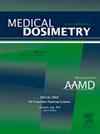通过混合神经网络对头颈部肿瘤进行自动定位和分割。
IF 1.1
4区 医学
Q4 ONCOLOGY
引用次数: 0
摘要
目的:头颈部(H&N)癌症占美国癌症病例的 3%。头颈部肿瘤的精确分割对于制定治疗计划和实施个性化治疗剂量至关重要。我们旨在开发一种自动肿瘤定位和分割方法,以提高临床效率,最终改善治疗效果:在这项研究中,我们开发了一种混合神经网络(HNN),将物体定位和分割整合到一个统一的框架中。它包括 4 个阶段:预处理、HNN 训练、对象定位和分割以及后处理。我们利用由 48 名患者的 PET 和 CT 图像组成的数据集,设计了一个混合神经网络(HNN),该网络由 YOLOv4 对象检测模型和用于图像分割的 U-Net 模型组成。YOLOv4 用于识别感兴趣区(ROI),而 U-Net 则用于精确的图像分割。在实验中,我们采用了两种对象检测架构来识别可能的肿瘤区域,即 YOLOv4 和 Faster-RCNN。我们对两者的评价指标进行了评估和比较:我们评估了 3 种模型组合的性能:结果:我们评估了 3 种模型组合的性能:YOLOv4 + U-Net、Faster-RCNN + U-Net 和单独的 U-Net。模型的评估基于灵敏度、特异性、F-Score 和联合交叉(IoU)。YOLOv4 + U-Net 达到了最佳值,灵敏度为 0.89,特异度为 0.99,F-Score 为 0.84,IoU 为 0.72:实验结果表明,混合神经网络的性能令人印象深刻,表明它有潜力成为一种有价值的 H&N 肿瘤分割工具。本文章由计算机程序翻译,如有差异,请以英文原文为准。
Automated tumor localization and segmentation through hybrid neural network in head and neck cancer
Purpose
Head and Neck (H&N) cancer accounts for 3% of cancer cases in the United States. Precise tumor segmentation in H&N is of utmost importance for treatment planning and administering personalized treatment dose. We aimed to develop an automatic tumor localization and segmentation method in enhancing the clinical efficiency and ultimately improving treatment outcomes.
Approach
In this study, a hybrid neural network (HNN) was developed by integrating object localization and segmentation into a unified framework. It consists of 4 stages: preprocessing, HNN training, object localization and segmentation, and postprocessing. We utilized a dataset consisting of PET and CT images for 48 patients and designed a Hybrid Neural Network (HNN) which consists of YOLOv4 object detection model + U-Net model for image segmentation. YOLOv4 was used to identify regions of interests (ROI), while the U-Net was employed for the precise image segmentation. In our experiments we considered 2 object detection architectures to identify possible tumor regions, namely YOLOv4 and Faster-RCNN. The evaluation metrics for both were evaluated and compared.
Results
We evaluated the performance of 3 model combinations: YOLOv4 + U-Net, Faster-RCNN + U-Net, and U-Net alone. The models were evaluated based on Sensitivity, Specificity, F-Score, and Intersection over Union (IoU). YOLOv4 + U-Net achieved the best values with Sensitivity of 0.89, Specificity of 0.99, F-Score of 0.84, and IoU of 0.72.
Conclusion
A new hybrid neural network (HNN) for fully automatic tumor localization and segmentation was developed and the experimental results. showcased the HNN's impressive performance, indicating its potential to be a valuable H&N tumor segmentation tool.
求助全文
通过发布文献求助,成功后即可免费获取论文全文。
去求助
来源期刊

Medical Dosimetry
医学-核医学
CiteScore
2.40
自引率
0.00%
发文量
51
审稿时长
34 days
期刊介绍:
Medical Dosimetry, the official journal of the American Association of Medical Dosimetrists, is the key source of information on new developments for the medical dosimetrist. Practical and comprehensive in coverage, the journal features original contributions and review articles by medical dosimetrists, oncologists, physicists, and radiation therapy technologists on clinical applications and techniques of external beam, interstitial, intracavitary and intraluminal irradiation in cancer management. Articles dealing primarily with physics will be reviewed by a specially appointed team of experts in the field.
 求助内容:
求助内容: 应助结果提醒方式:
应助结果提醒方式:


